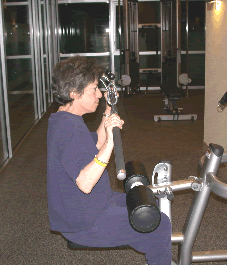 |
| Woman using an exercise machine |
By Amy Rauworth
Exercise professionals often quote guidelines and standards and speak in terms such as VO2 max or MET levels. It is essential to translate the science to practice, but it is equally important to understand that a tailored approach to exercise prescription is needed to ensure a successful outcome.
Following are tips for the exercise professional or personal trainer working with individuals with disabilities:
- Discuss health history, medications, and any associated or secondary conditions that may be related to the client’s disability.
- Test flexibility, balance, strength, and cardiovascular endurance before beginning an exercise program to provide a clear baseline measure. There are many field-based tests that do not require clinical evaluations of oxygen consumption or specialized equipment. Refer to the Fitness Assessments Toolkit for ideas.
- Do not be overprotective or assume what a client can or cannot do.
- Engage the client in interactive discussions that identify his or her specific goals and objectives of the exercise program. If the goals are functional in nature such as using the stairs or carrying a bag of groceries, test abilities before beginning the exercise program and re-evaluate every 12 weeks. (If the disability is progressive or if there is a change in health status, more frequent evaluations may be necessary.)
- Determine the client’s barriers to exercise, such as lack of accessible equipment in the fitness center or unsafe neighborhoods that do not allow outdoor activity.
- Ask clients what motivates them to continue exercising and determine the best strategy to provide that support.
- Be creative when designing an exercise program. Exercise that can be done in a gym setting can be supplemented with outdoor exercise or home exercise that incorporates daily activities and tasks. When choosing the exercise venue, it is important to consider what environment the client enjoys the most.
- Network with a team of health care professionals such as doctors, nurses, and physical and occupational therapists to provide guidance on any scope of practice that is outside of your knowledge base.
- Maintain accurate and detailed S.O.A.P. notes that include Subjective statements made by the client, Objective modalities or activities, Assessment of client’s progress and compliance, and the Plan for the next exercise session. It is also important to ask if the client has taken his or her medication for that day and to determine the level of pain or fatigue that may vary day by day.
- Provide the client with copies of the daily S.O.A.P. notes and offer to send then to his or her primary care physician.
Below is a brief excerpt from an interview with June Kailes, who offers professional exercise advice for working with individuals with cerebral palsy.
June Kailes is author of Health, Wellness, and Aging with Disability and is a well-known National Disability Policy Consultant. She has been diagnosed with ataxic cerebral palsy. June utilizes a scooter for ambulation and to manage musculoskeletal pain. Her job requires long hours on the computer, on the phone, on planes, and in meetings. Since her job and lifestyle are sedentary, she makes physical activity a priority. She works out regularly and can provide insight to exercise professionals from both personal and professional contexts.
When asked what motivates her to continue her exercise program, June underscores concerns about losing function and experiencing increased pain. As she says, “In the past we didn't age, we just died! We are the first generation to live this long, so the question is not, ‘Will we live?', but ‘How will we live?'" She also said, “Many of us will probably live longer than we think, so we have to think about what we can influence or change in terms of the quality of our years as we age." June advises the exercise professional not to minimize the symptoms that she is experiencing and simply relate them to the aging process. “What's coming into sharp focus for many of us is that the changes brought about by regular aging (yet to be clearly defined) can play havoc with a person's ability to function." Like many of her fellow baby boomers, she states she expects more, not less with age! When asked what she enjoys the most about exercise, June said, “When it's over…a sense of accomplishment!"
June also encourages the exercise professional to be specific in regards to the type and amount of exercise recommended. She feels that the more she knows about why she is doing an exercise and what it will help, the more likely she will be to include it in her activities. June advises the exercise professional to speak in non-clinical terms, to be creative in exercise design, to ask for her suggestions or thoughts, and to challenge their clients with cerebral palsy. She stresses the importance of understanding the secondary and associated conditions of cerebral palsy and the importance of tailoring the program to her wants and needs. June often travels and sometimes encounters barriers such as the lack of accessible fitness centers in hotels or equipment that is not accommodating. When fitness centers lack accessible options, she will walk the hotel halls and do flexibility and strength exercises in her room. June anticipates that exercise will always be part of her life. She recognizes the benefits and feels the investment of time is more important for her than for people without disabilities.
Updated 4/13/2020

